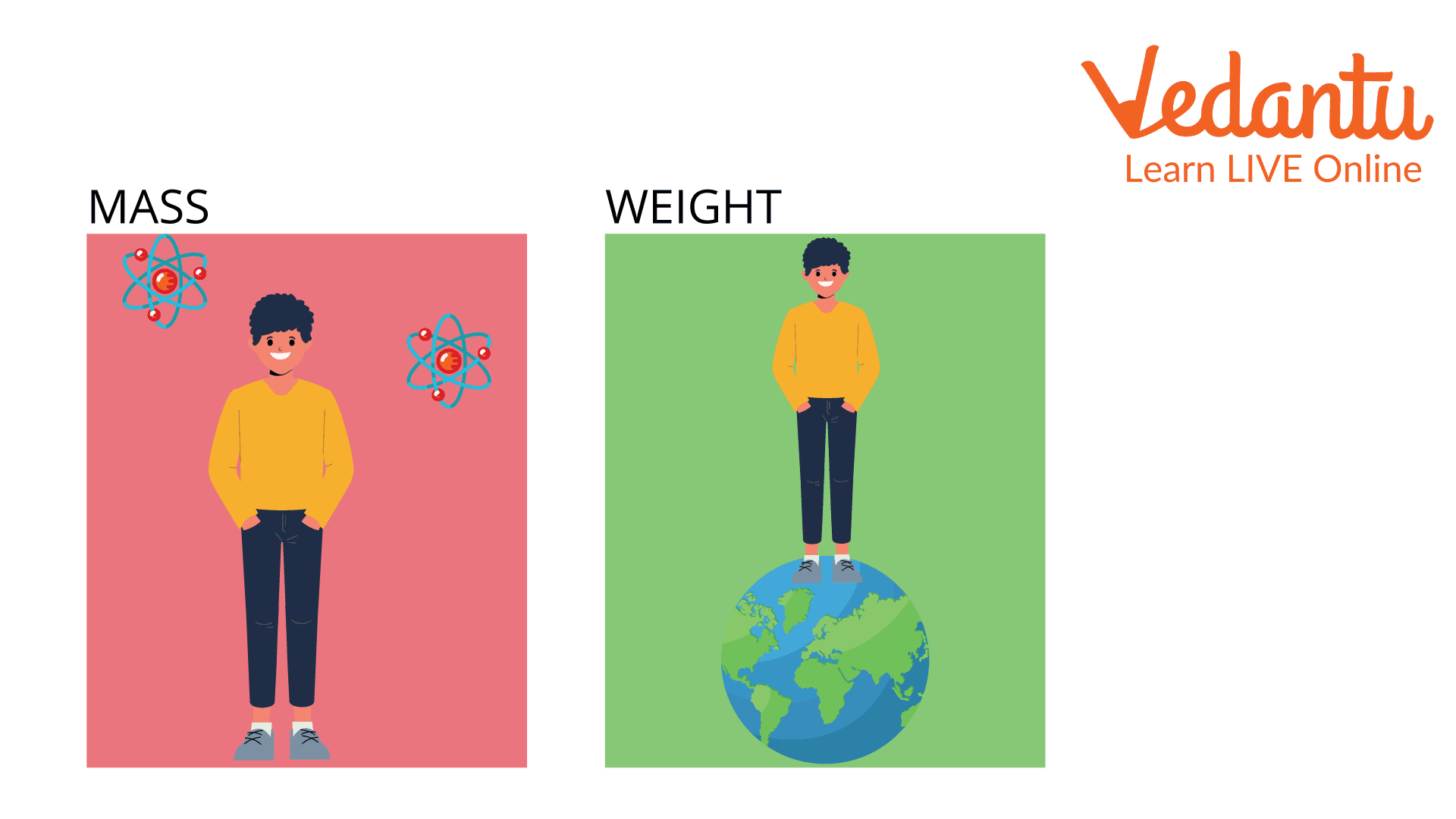




Introduction - Mass and Weight

Mass and Weight
Mass is a body's matter. Humans have bones, muscles, tissues, and blood cells. They comprise the body's bulk. A person or thing on the moon may be weightless, but have the same mass everywhere. Weight is a quantity. In science and engineering, an object's weight is connected to its gravity or holding force. Weight measures an object's heft.
What is Mass?
When you visit the doctor for a checkup, the doctor will often have you step on a scale to check your weight. But what if the office of your doctor was on the moon? Would you still weigh the same? No, you would be a lot lighter because there is no gravity. But you would be the same size as you are on Earth. How could that be? The idea of mass comes into play here.
It is the most fundamental property of matter and one of the most basic quantities in physics. We can say that the amount of matter in a body is its mass. The kilogram is the SI unit of mass (kg). A body's mass doesn't change at any point. Only in extreme situations where a lot of energy is given or taken from a body. For example, in a nuclear reaction, a small amount of matter is turned into a lot of energy, which makes the amount of matter in the substance smaller.
What is Weight?
The shape of the Earth is not a perfect sphere but an oblate spheroid. This means that a person standing at the equator is farther from the Earth's centre than someone standing at the north pole. Since acceleration due to gravity is proportional to the inverse of the square of the distance between two objects, a person standing at the north pole would feel more weight because he is closer to the Earth's centre than someone standing at the equator.
The weight of something is how heavy or how much mass it has. One example of weight in science is the 100 pounds weight of a person.
How is Weight Measured?
Newton is the same force unit for weight. The second law of motion can be used to compute it.
F = mg
Here, "mg" represents the Earth's gravitational acceleration, and "F" represents the object's weight in newtons.
What is the Difference Between Mass and Weight?
What is Weightlessness?

The Weightlessness
Have you ever been in an elevator? Notice how you feel like you're getting lighter as the elevator goes down? That's because the weight you feel is your "perceived weight" or "effective weight." This is the force that the floor puts on you that is equal and opposite to the weight you put on it.
Now, if we remove the floor and let you fall freely, there is nothing to push against you. Because of this, you will feel like you don't have any weight, even though you move faster because of gravity and mass. The effective weight is zero, so this is what happens. Now, let's go back to our elevator. When the elevator goes down, it moves in the direction of gravity. This means that your weight goes down because the net acceleration due to gravity goes down.
The same thing happens to astronauts in the International Space Station. While the space station is orbiting the earth, everything in it, including the astronauts, is falling toward it, so the astronauts have no weight and can move around freely. The most important thing to remember in all these situations is that weight can go up or down depending on how fast something moves because of gravity, but mass stays the same.
Facts About Weight and Mass
The Greek word "maza," which means "lump of dough," is where the term "mass" originates.
A metric tonne is equivalent to 1000 kg.
Weight is a force in physics and has a Newton unit of measurement. The physicist Isaac Newton, who is credited with discovering gravity, is honoured with the name of this unit of measure.
According to the Greek philosopher Plato, weight is the primary inclination of objects to seek their relatives.
Gravity can change by up to 0.5%, depending on where we are on the Earth.
The amount of mass in space is determined by its density.
Things weigh more at sea level than at a mountain's peak.
Conclusion
We often use the words "mass" and "weight" as if they mean the same thing in everyday life. But in science, Mass and weight are not the same. Mass is a way to measure how much matter is in something. It depends on what kind of atoms make up the object and how many of them there are. The weight of a pineapple or wooden baseball bat is about 1 kilogram.
FAQs on Facts About Weight
1. What is the scientific definition of weight?
In science, weight is the measure of the force of gravity pulling on an object. It is not the same as mass, which is the amount of matter an object contains. Because weight is a force, its value depends on the strength of the gravitational field at the object's location.
2. What is the main difference between mass and weight?
The main difference is that mass is the amount of 'stuff' in an object and is constant everywhere, while weight is the gravitational force acting on that object and can change with location. For example, your mass is the same on Earth and the Moon, but you would weigh much less on the Moon because its gravity is weaker.
3. How does gravity affect an object's weight?
Gravity has a direct effect on weight. The stronger the gravitational pull of a planet or celestial body, the more an object will weigh. This is why an object weighs about six times more on Earth than it does on the Moon. Without gravity, an object would have mass but would be effectively weightless.
4. Can an object's weight change even if its mass stays the same?
Yes, an object's weight can change without any change in its mass. Weight is calculated by multiplying an object's mass by the acceleration due to gravity (W = mg). If you move the object to a location with different gravity, like from a valley to a high mountain or from Earth to Mars, its mass will remain constant, but its weight will change.
5. How is weight measured and what are its standard units?
Weight is measured using an instrument like a spring balance or a weighing scale. The official scientific unit for weight, which is a force, is the Newton (N). In everyday language, people often use units of mass like kilograms (kg) or pounds (lbs) to describe weight, though this is a common simplification.
6. Does a bigger object always weigh more than a smaller one?
No, a bigger object does not necessarily weigh more. An object's weight depends on its mass and density, not just its size (volume). For example, a large pillow is much bigger than a small brick, but the brick weighs significantly more because it has more mass packed into a smaller space.
7. What is the concept of weightlessness?
Weightlessness is the state of experiencing no apparent gravitational force, like floating. This occurs when an object is in free fall, where gravity is the only force acting on it. Astronauts in orbit feel weightless because their spaceship and everything inside it are continuously falling toward Earth together.
8. Why is understanding the concept of weight important?
Understanding weight is crucial in many fields for practical reasons. For example:
- In engineering, it is essential for designing bridges, buildings, and vehicles that can safely support specific loads.
- In commerce and trade, it is used to measure goods to determine their price.
- In health and fitness, it is a key metric for monitoring physical well-being.









